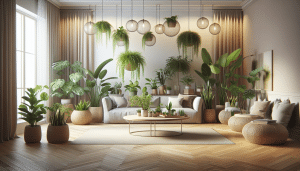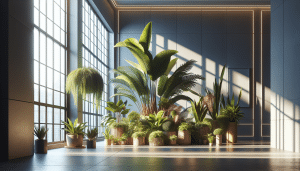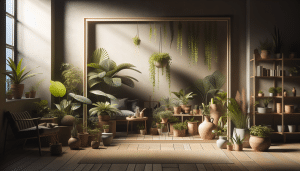You Won’t Believe How Indoor Plants Change Spaces
Daniel Fisher August 26, 2025
Curious about transforming your home into a calming retreat? Discover how indoor plants add beauty, purify air, and boost mood while exploring practical tips for care, placement, and a thriving green oasis. Learn how creating a lush atmosphere is easier than you might think.
Why Indoor Plants Are More Popular Than Ever
Walk into any stylish living room, and you’ll likely spot a gorgeous array of indoor plants. These green companions have surged in popularity, captivating both apartment dwellers and homeowners. The reasons go far beyond decoration. People report improved mood, air quality, and even increased productivity after introducing greenery into their personal spaces. As living spaces get smaller and daily stress is ever-present, many turn to houseplants to create a peaceful, invigorating environment right inside their homes.
The recent boost in remote work may play a part in this indoor plant renaissance. More individuals spend time at home, seeking new ways to refresh their space naturally and inexpensively. Plants offer a beautiful solution. From the bold fiddle leaf fig to petite succulents, there’s an indoor plant for every style and skill level. Many find themselves exploring propagation, vertical gardening, and other creative methods for displaying their leafy friends.
Another reason for the indoor plant boom is accessibility. Nurseries and online retailers provide an astounding variety of houseplants, making it easy to find the perfect botanical match. Even those without outdoor gardens can experience the satisfaction of nurturing a living thing. Add to this the growing awareness of eco-friendly living, and it becomes clear why indoor plants hold such wide appeal for city dwellers and suburban homeowners alike. They’re more than décor—they’re a lifestyle shift.
Health Benefits of Bringing Greenery Indoors
Studies show that certain indoor plants can help improve indoor air quality. Common choices like peace lilies, spider plants, and snake plants naturally filter toxins such as benzene and formaldehyde, making breathing just a bit easier at home (https://www.epa.gov/indoor-air-quality-iaq/indoor-air-pollution-introduction). While plants alone won’t replace a quality air filtration system, they do support a healthier micro-environment indoors.
There’s also a psychological advantage. Research indicates that time spent nurturing plants can reduce stress and anxiety. People often report feeling calmer and more centered after digging into soil or simply sitting among their plants. In healthcare settings, the presence of greenery has been linked to faster recovery, lower stress levels, and improved patient outlooks. These subtle health bonuses add up, making them a great supplement to traditional wellness efforts.
Plants can also impact physical healing and focus. For example, students and professionals working near plants may notice slight boosts in concentration and memory retention. Some employers even encourage small desk plants to help employees stay refreshed. The simple presence of greenery provides visual relief, combating screen fatigue and contributing to a more balanced mental state overall. It’s a compelling case for adding more indoor plants to every room.
Choosing the Perfect Indoor Plants for Your Home
When deciding which indoor plants to bring home, it’s smart to consider lighting conditions, humidity, and your own care style. Low-light tolerant varieties like pothos, snake plant, and ZZ plant thrive even without direct sunlight—perfect for apartments or north-facing windows. Bright, sunlit rooms may allow for more delicate varieties such as fiddle leaf figs or rubber trees. Matching a plant’s needs to your environment makes care simple, maximizing your enjoyment.
Pet owners need to be particularly mindful. Some houseplants, such as philodendron or aloe vera, can be toxic to cats and dogs if ingested. Fortunately, there are animal-friendly choices like spider plants, Boston ferns, and parlor palms that offer beauty without risk (https://www.aspca.org/pet-care/animal-poison-control/toxic-and-non-toxic-plants). Checking toxicity guides before purchasing helps keep your entire household safe while still enjoying lush foliage.
Personal taste plays a huge role in plant selection. Some prefer modern, sculptural plants with bold leaves—like monstera deliciosa or bird of paradise. Others love the gentle appeal of trailing vines and petite succulents. Visiting a local nursery can inspire new ideas, while browsing online plant shops offers endless options. No matter your skill level, there’s a plant variety suited for you and your unique living space.
Creative Ways to Display Indoor Plants
Plant placement makes a tremendous difference. Consider placing small potted plants on open shelving, clustered in groups for texture and color. Larger specimens anchor corners and create natural room dividers, lending structure to open-plan spaces. Macramé hangers or wall-mounted pots save floor space and draw the eye upward, adding drama and interest to any room.
Creating themed arrangements is another great way to personalize your plant collection. Grouping plants according to their watering or light needs simplifies care and lets you achieve harmonious displays. Try a succulent tray for a sunny window or an array of lush ferns in a moist bathroom. Layer with decorative stones, baskets, or unique planters to reflect your personal style. Mixing plant sizes and heights produces a designer look without the need for professional help.
For those with limited natural light, artificial grow lights open new possibilities. Compact LED systems let you cultivate everything from herbs to flowering houseplants, even in rooms without windows. Modular plant walls add visual depth and transform blank areas into living artworks. Whether space is abundant or tight, innovative placement makes the most of every square inch, keeping indoor gardens thriving throughout the year.
Watering and Maintaining a Healthy Indoor Garden
The most frequent question for new plant owners is about watering. While each plant variety has its own needs, most benefit from letting the soil dry slightly between waterings. Overwatering—often more damaging than neglect—can lead to root rot and yellowing leaves. Using a moisture meter or simply testing soil with your finger helps prevent these common pitfalls. Establishing a routine based on plant type and season sets up long-term success.
Humidity and temperature are equally important for robust plants. Many tropical species flourish with occasional misting or by placing trays of water nearby to increase moisture in the air (https://hgic.clemson.edu/factsheet/care-of-indoor-plants/). Central heating can dry out leaves and soil, so monitoring these factors is especially key in winter months. A little extra attention can go a long way in ensuring plants remain healthy and vibrant.
Pruning and regular checkups keep indoor plants in peak condition. Remove faded flowers and damaged leaves to redirect energy into new growth. Fertilize during the growing season with a gentle houseplant formula. Watch for common pests—like spider mites or fungus gnats—and treat early using natural remedies or low-impact controls. A bit of ongoing care ensures you’ll enjoy a thriving indoor garden for years.
Plants as a Sustainable Living Choice
Adding houseplants supports an eco-friendly lifestyle. Not only do they absorb carbon dioxide and emit oxygen, but they also reduce stress on HVAC systems by creating natural shade indoors. Some large-leaf varieties lower room temperatures, offering an organic way to cool living spaces (https://www.energy.gov/energysaver/landscaping-energy-efficient-homes). Even growing culinary herbs on a sunny sill reduces waste and adds homegrown freshness to meals.
Plant propagation is another sustainable practice. Learning to multiply plants from cuttings or divisions encourages resourcefulness and helps share greenery with family and friends. Many urban gardeners find joy in swapping clippings, fostering a sense of community around sustainable choices. Less packaging, shipping, and commercial nursery waste means a lighter environmental footprint for each new plant you introduce into your home.
Lastly, integrating indoor plants taps into natural cycles and rhythms. Seasonal changes, watering, and new growth connect people to the passage of time and the broader environment. Over time, even small steps toward sustainability—like composting plant trimmings or choosing peat-free soil—enhance the satisfaction and meaning indoor gardening brings.
References
1. U.S. Environmental Protection Agency. (n.d.). Indoor Air Pollution–An Introduction for Health Professionals. Retrieved from https://www.epa.gov/indoor-air-quality-iaq/indoor-air-pollution-introduction
2. American Society for the Prevention of Cruelty to Animals. (n.d.). Toxic and Non-toxic Plants. Retrieved from https://www.aspca.org/pet-care/animal-poison-control/toxic-and-non-toxic-plants
3. Clemson Cooperative Extension. (n.d.). Care of Indoor Plants. Retrieved from https://hgic.clemson.edu/factsheet/care-of-indoor-plants/
4. U.S. Department of Energy. (n.d.). Landscaping for Energy-Efficient Homes. Retrieved from https://www.energy.gov/energysaver/landscaping-energy-efficient-homes
5. Botanic Gardens Conservation International. (n.d.). Home Gardening Resources. Retrieved from https://www.bgci.org
6. Kansas State University Research and Extension. (2020). Houseplants Guide. Retrieved from https://www.bookstore.ksre.ksu.edu/pubs/MF2878.pdf








